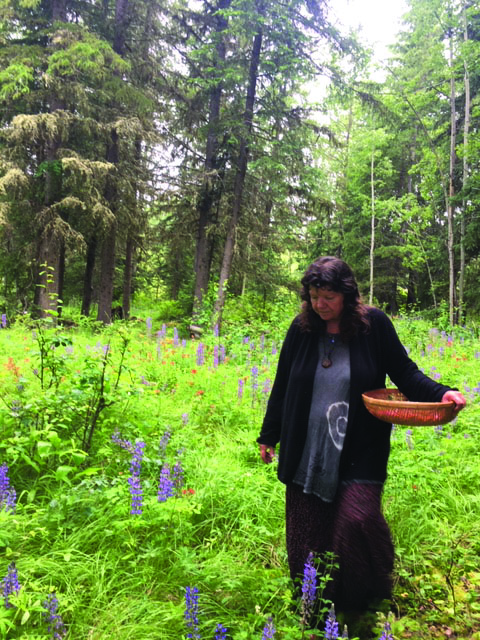Article by Maggie Ranger –
Living in the Cariboo we are surrounded by an abundance of flora and fauna. Spring and summer are the busiest time for an herbalist, gathering, foraging, and harvesting medicinal plants.
There are many medicinal plants growing in our backyards in the Cariboo, and the trick is to take note of the different microclimates in our region. You may miss an opportunity to harvest in one area but can simply travel to a higher altitude to find the same plant at an earlier growing stage. For example, wild roses bloom on the west side of the Fraser River first, then in the Williams Lake river valley, next in 150 Mile House to Horsefly area, and lastly in Likely.
In our travels to harvest plants, we are mindful of the regions and the people of those lands—Tsilhqot’in in the west, Secwepemc east of the Fraser River, and Carrier in the north. It is important to respect our First Nations neighbours, and it is good practice to ask permission from the people with a gift of tobacco, sweet grass, or preserves, where possible. One can also gift the items to the land where you are harvesting.
If you are gathering plants, remember to only take some of the herb, shrub, berries, or mushrooms. It is important to only harvest less than one-third of a particular plant in that patch.
Summer is the best time to harvest leaves and flowers, as the plants energy is stored here. The energy and potency of a plant begins in the roots in spring, moves into the leaves and flowers in late spring and summer, and returns to the roots in the fall. It is good practice to treat plants in a sacred manner and thank each plant, telling them your intention before harvesting, and offering tobacco or sage before beginning to harvest. Always take with gratitude and humbleness and with great care not to damage the rest of the plant. Harvest away from roadsides or near places where pollutants, such as herbicides, are spread.

Wild Rose
“The world smells of roses, the sunshine is like powered gold over grassy hill sides.” This quote by Maud Hart Lovelace embraces the essence of early summer when wild roses are flowering. Wild roses (Rosa acicularis, Rosa nutkana) are my favourite plant to harvest. I love picking wild rose petals and being immersed in their heavenly fragrance. Rose petals are a sedative, antiseptic, nervine, great for digestive and to build up your immune system, full of antioxidants, stress reducer, heart medicine, and they truly soothe the soul. Roses can be made into rose oil, petals can be dried for tea, and rosehips can be eaten or dried for their high vitamin C content.
Stinging Nettle
Stinging nettles, Urtica dioica, while readily available during early and late spring at lower elevations, can be found at higher elevations during the summer months. Early nettle leaves are rich in minerals, vitamins, and amino acids. They are a great spring tonic and strengthen the kidneys, lungs, intestines, arteries, and adrenals. They are delicious steamed and eaten, dried for tea, or made into an infusion. “The whole plant is powerfully medicinal from the roots to the seed,” says herbalist, Juliette Levy.
Self-Heal
The Self Heal plant, Prunella vulgaris, with its stunning, bee-shaped purple flowers, is a delight when it pops up through the grass during the summer. It has large, flat leaves and can be found in lawns, forests, and meadows. The purple flower can be harvested and infused into oil and used for skin conditions, burns, scrapes, and infections. It can also be dried and used as a tea or made into a tincture and has been used for inflammatory bowel disease, Crohn’s, colitis, diarrhea, colic, and sores in the mouth and throat.
Arnica
Arnica montana is found throughout Cariboo forests in the summer months, and has soft, hairy leaves and a radiant yellow flower. It is a beautiful sunshine yellow flower in the forest with a bright, pungent smell when harvested. Arnica flowers can be cut up and infused into oil and made into a balm or oil used for massage, bruises, sprains, muscle damage, aches, and pains or as an anti-inflammatory. Note: Do not use on open wounds or consume orally unless as a homeopathic remedy. If I dance all night, and my knees feel like buckling, I rub on some Arnica and I’m good by morning!
I have only touched on a few medicinal herbal plants growing around us. There are so many more. It is a blessing to hold and share knowledge of plants and to harvest plants in the Cariboo. Get your baskets out, make some tea, and discover the world of plants around you.
Maggie Ranger is a chartered herbalist from Horsefly, BC, and produces teas, salves, tinctures, and many other products gathered in the Cariboo Region and from her garden. To see more visit Earthdancebotanicals.com

